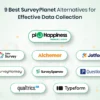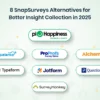Introduction:
Suppose a classroom full of students where they actively participate improving their learning experience. They feel heard and valued as they provide valuable insights that contribute to positive change.
The Power of Student Voices:
Asking feedback from students is not just a checkbox to be filled as it is a powerful tool for the growth of learning. The valuable feedback from students offers informative point of view on the learning process, highlighting strengths, weaknesses, and areas for improvement. This valuable input can inform:
- Teaching methods: Teachers can track their teaching styles and course content based on student’s feedback, leading to more engaging and effective learning experience.
- Curriculum development: Feedbacks can identify gaps in the curriculum or suggest new ways of teaching.
- Resource allocation: Institutions can prioritise resources based on a student’s needs, ensuring they have access to new tools.
- Student engagement: Institutions shows their commitment to students success, fostering a sense of belonging and oneness by actively responding to feedback.
The loop for Student Feedback:
The true magic lies in closing the Student Feedback Loop. This means not just collecting feedback but acting upon it and reciprocating the results back to students. This demonstrates transparency, builds trust, and encourages further engagement.
1. Technology as a Catalyst:
Technology is an important denominator as it promotes student feedback app, systems, and software that can streamline the process, making it easier for students to provide feedback and for institutions to analyze and respond to it. These tools offer features like:
- Anonymous surveys: Encourage honest feedback without fear of judgement.
- Real-time feedback: Gather feedback during or immediately after learning activities.
- Data analysis dashboards: Gain insights into trends and identify key areas for improvement.
- Communication channels: Share feedback summaries and action plans with students.
Boost School Insights with Our Easy Surveys❤️
Elevate Education Today with piHappiness!
2. Understanding the Student Feedback Loop
a. Definition and Components: A student feedback loop in layman’s term is process whereby students provide their perspectives on their learning experience, analysing institutions and responding to it, and the results are reverted to students, influencing future learning experiences. This loop consists of three key components:
- Data Collection: This involves gathering data collection in the form of feedbacks using various methods like surveys, interviews, focus groups, or lectures.
- Analysis and Action: Then the collected data is analysed to identify recent trends and areas for improvement. Institutions then develop action plans based on the insights gained.
- Communication and Follow-up: After that the action plans and overall progress are communicated back to the students by demonstrating transparency.
b. Importance of a Structured Mechanism: While informal feedback is valuable, implementing a structured student feedback app has benefits:
- Consistency: Collection of feedback is consistent and avoids gaps or biases.
- Data-driven decision-making: Quantitative and qualitative data are provided for correct decision-making.
- Improved communication: It improves communication by breaking barriers in between for building trust and engagement.
- Empowerment: Gives students a platform to speak up about their learning process.
c. Benefits for All: Academic institutions reap numerous benefits with student feedback app:
- Enhanced teaching and learning: By improving their teaching methods, curriculum adaptability and resource allocation lead to better learning outcomes.
- Increased student engagement and satisfaction: If students actively participate, it boosts engagement which leads to higher satisfaction.
- Commitment to quality: They are transparent and responsive to feedback and showcase a commitment to students opinions.
d. Students also experience significant benefits:
- Personalised learning: Feedback helps students in leading to a more personalised and effective learning experience.
- Sense of agency and ownership: Students feel their voices are heard and valued.
- Development of critical thinking and communication skills: Providing feedback hones critical thinking, communication, and self-reflection skills.
Why the Variety?
Each method offers unique strengths. Quantitative surveys provide clear data points, while qualitative surveys uncover hidden concerns. Focus groups allow deeper exploration, while exit interviews offer valuable hindsight. Combining methods paints a richer picture of student experiences.
Beyond the Numbers: Numbers alone do not tell the whole story so qualitative data adds context and understanding.
3. Utilizing software for Student Feedback:
a. Stepping into the Digital Age: Paper surveys are slowly becoming a myth as student feedback software offers a range of advantages:
- Increased response rates: Convenient online access and mobile-friendly interfaces encourage participation.
- Real-time insights: Get instant feedback and identify emerging issues quickly.
- Data analysis made easy: Powerful tools automatically analyse results, saving time and effort.
- Enhanced anonymity: Secure online platforms encourage honest and candid feedback.
- Centralised data storage: Easily access and compare feedback over time and across different areas.
b. Choosing the Right Tool: With numerous options available, finding the right software is crucial. Here are key features to consider:
- 1. User-friendly interface: Both students and administrators should navigate the student feedback system platform easily.
- 2. Customization options: Choose question types, design surveys, and tailor the experience to your needs.
- 3. Data analysis capabilities: Track trends, generate reports and examine important insights.
c. Inspiration Through Success: Seeing real-world examples can be powerful. Here are two case studies showcasing successful software implementation:
- Case Study 1: Estee Lauder used a feedback app to collect course evaluations. The user-friendly interface and anonymous feedback encouraged high participation. Analysis revealed areas for improvement in training methods, leading to development workshops and improved satisfaction.
- Case Study 2: Cisco used a comprehensive feedback platform for program assessments. Program lacking and course gaps were identified by the software that were able to analyse quantitative and qualitative data.
Beyond the Basics:
- Pilot test your survey: Gather feedback on the clarity and flow before full launch.
- Segment your audience: Tailor surveys to specific groups for more targeted insights.
- Seek external feedback: Consider involving faculty, staff, or external experts in analysis and action planning.
4. Future Trends: Charting the Course for Student Feedback in Education
a. Embracing Emerging Technologies: Artificial intelligence (AI): AI-powered tools like student feedback system can analyze feedback data, identifying hidden patterns and trends.
- Virtual Reality (VR) and Augmented Reality (AR): Immersive simulations can provide students with personalized feedback experiences
- Blockchain technology: Blockchain’s security ensure students feedback remains confidential and accessible as its data storage and sharing is revolutionary.
b. Personalized Learning through Feedback:
- Adaptive learning: Analyzing individual feedback data, learning platforms can adapt to each student’s needs, providing personalized learning pathways and targeted interventions.
c. Student Feedback Shaping Educational Policies:
- Empowering student voices: Students will have a stage to voice out their opinions through online forums, feedbacks and even student-led committees.
- Data-driven decision-making: Policymakers will increasingly rely on students feedback data and make effective changes.
5. Conclusion: Unlocking the Transformative Power of Student Feedback
a. The Student Voice: A Cornerstone of Success: Student voices are not just background noise. they are the stimulators for shaping a vibrant and effective learning experience. By listening and responding accordingly, we can create an interesting learning experience for them.
b. Continuous Feedback: The Engine of Transformation: The transformative potential of continuous feedback cannot be overstated. It’s not just about collecting data, it’s about creating a feedback loop that fuels improvement, innovation, and a deeper understanding of what truly matters in education.
Hope this blog series provides valuable insight to you. Happy reading!








